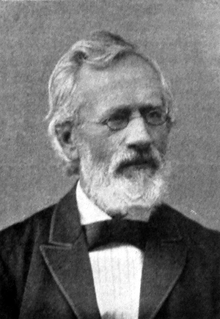Gisle Johnson
Gisle Johnson | |
|---|---|
 Gisle Johnson (1889) | |
| Born | (1822-09-10)September 10, 1822 Halden, Østfold, Norway |
| Died | July 17, 1894(1894-07-17) (aged 71) Nøtterøy, Vestfold, Norway |
| Nationality | Norwegian |
| Education | University of Christiania |
| Occupation(s) | Lutheran Theologian and educator |
| Theological work | |
| Tradition or movement | Lutheran orthodoxy Erlangen Theology Johnsonian Revivals |
| Notable ideas | Lay Preaching Dogmatics of Faith |

Gisle Christian Johnson (10 September 1822 – 17 July 1894) was a leading 19th-century Norwegian theologian and educator.[1]
Biography
Gisle Christian Johnson was born at Fredrikshald (now Halden) in Østfold, Norway. He grew up at Kristiansand in Vest-Agder. He was a son of engineer and architect Georg Daniel Barth Johnson (1794-1872). He studied theology at the University of Christiania (now University of Oslo) and graduated in 1845. In 1849 he became a lecturer at the University of Christiania, and in 1860 a professor, first in systematic theology and Dogmatic theology and from 1875 in church history.[2] [3]
Raised in a Pietist Lutheran family, Johnson was deeply influenced from an early age by the revivalistic preaching of Hans Nielsen Hauge (1771-1824). It was a Haugean, Ole Pedersen Noe, who would influence Johnson to pursue vocational ministry. Likewise, an early school teacher, Christian Thistedal (1813-1876), was also a profound theological influence on Johnson, educating him in the more formal aspects of theological including Greek, Hebrew, and Syriac prior to his entrance to the university. During his time in the university Gisle excelled in his studies, reading well beyond his required course of study and digesting literature from Kierkegaard, Bengel, Gesenius, Vitringa, and others. In 1845 Johnson passed his university exit examinations "with distinctions," and was soon after offered the post of lecturer of theology, which he turned down in favor of a scholarship to study theology abroad in Germany beginning in 1846.[4] There, he became profoundly influenced by the Erlangen School of Theology, which appealed to his own theological sensibilities by its appeal to Scripture, Confessions, and religious experience as its threefold religious principles. He later reflected,
This University offered me such a rich assortment (samling) of all that could possibly have been of interest and meaning for my studies, that ... if I had been able to spend another half year abroad would in a moment have thought of nothing other than Erlangen.[4]
When Johnson returned to Norway, he brought with him an eclectic mix of German theology, pietism, and Lutheran Confessionalism, which emerges in his most significant theological work, Grundrids af den Systematisk Theologi, a work which incorporates a Kierkegaardian-style prolegomena on faith in its three stages, followed by a dogmatic account stemming from realities of justification and regeneration.[5] It was this focus on faith and the new birth that would prove to be a particular element of emphasis in Johnson's preaching ministry, which focused on the need for God's grace in the heart, a ministry which appealed to laypeople and ministers alike and which became known as the Johnsonian Revivals.[4]
In 1855, he founded the Christiania Inner Mission Society (Christiania Indremissionsforening), in 1863 the Lutheran Church Official Journal (Luthersk Kirketidende) and in 1867 the Norwegian Luther Foundation (Den norske Lutherstiftelse). In 1858 he established, together with Carl Paul Caspari, an annual publication entitled Theologisk Tidskrift for den evangelisk-lutherske Kirke i Norge which he edited until 1891. Religiously he followed strict Confessional Lutheranism. During a revival which went across Norway during the 1850s, he reflected the pietistic and ecclesial tradition of Hans Nielsen Hauge. Johnson emphasized a theology that was both based on the experience of faith and grounded in Lutheran orthodoxy. [6] [7] [8] [9]
He was a member of the Royal Norwegian Society of Sciences and Letters from 1858. He was appointed a Knight in the Order of St. Olav in 1866 and made a Commander 1st class in 1882. In 1879, he was conferred an honorary doctorate by the University of Copenhagen. He died during 1894 at Nøtterøy in Vestfold, Norway. Both Gisle Johnsons plass in the district of Grünerløkka in Oslo and Gisle Johnsons gate in Trondheim were named in his honor.[10][11]
Works
- Grundrids af Den systematiske teologi (Outlines of the systematic theology) (1878)
- Forelæsninger over dogmehistorien (Lectures in dogmatic history) (1898)
- Forelæsninger over den kristelige Ethik (Lectures on Christian Ethics) (1898)
See also
References
- ^ Gisle Christian Johnson (Store norske leksikon)
- ^ Jens Christian Eldal. "Georg Daniel Barth Johnson". Norsk kunstnerleksikon. Retrieved February 1, 2018.
- ^ Gisle Johnson (1822–1894) (lokalhistoriewiki.no)
- ^ a b c Nostbakken, Roger (1962). The theology of Gisle Christian Johnson: an inquiry into its sources, its nature and its significance (Dissertation). Princeton, NJ: Princeton Theological Seminary. pp. 34, 43, 227.
- ^ Johnson, Gisle (1897). Grundrids af den Systematisk Theologi [Outlines of Systematic Theology] (in Norwegian). Kristiana, Norway: Jacob Dybwabs.
- ^ Bernt Oftestad: Gisle Johnson - Teolog (Norsk biografisk leksikon)
- ^ 13 profiler ved Det teologiske fakultet gjennom 180 år (folk.uio.no)
- ^ Om oss (Luthersk Kirketidende)
- ^ Tarald Rasmussen: Det norske lutherske Indremisjonsselskap (Store norske leksikon)
- ^ Gisle Christian Johnson (Allkunne AS)
- ^ Bratberg, Terje, ed. (1996). Trondheim Byleksikon. Kunnskapsforlaget. p. 210. ISBN 82-573-0642-8.
- v
- t
- e











